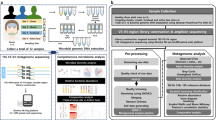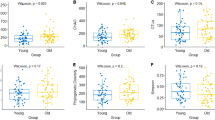Abstract
The Human Microbiome Project was first established to understand the roles of human-associated microbes to human health and disease. This study presents preliminary findings of Thai female facial skin microbiome using three pooled samples from groups of skin microbiome profiles, namely (1) healthy and (2) acne-prone young adults (teenage.hea and teenage.acn) and (3) healthy elderly adults (elderly.hea) based on standard dermatological criteria. These samples were sequenced using 454-pyrosequencing targeting 16S rRNA (V3–V4 regions). Good’s coverage index of greater than 92% shows sufficient sampling of our data for each group. Three unique OTUs for each microbiome profile (43, 258 and 59 for teenage.hea, teenage.acn and ederly.hea, respectively) were obtained with 134 shared OTUs among the three datasets. Based on Morisita–Horn similarity coefficient, age is the major factor that brings the community relationship factor closer. The comparison among the three datasets reveal majority of Gemmatimonadetes, Planctomycetes and Nitrospirae in the teenage.hea, whereas Firmicutes are more prevalent in teenage.acn and elderly.hea skin types. In addition, when comparing Thai facial microbial diversity with the 16S data from U.S. forehead female database, significant differences were found among orders of bacteria, pointing to possible differences in human ecto-flora.



Similar content being viewed by others
References
Aziz RK, Bartels D, Best AA et al (2008) The RAST server: rapid annotations using subsystems technology. BMC Genom. doi:10.1186/1471-2164-9-75
Baker GC, Smith JJ, Cowan DA (2003) Review and re-analysis of domain-specific 16S primers. J Microbiol Methods 55:541–555
Bowe WP, Logan AC (2011) Acne vulgaris, probiotics and the gut-brain-skin axis-back to the future? Gut Pathog. doi:10.1186/1757-4749-3-1
Cho I, Blaser MJ (2012) The human microbiome: at the interface of health and disease. Nat Rev Genet 13:260–270
Claesson MJ, O′Sullivan O, Wang Q et al (2009) Comparative analysis of pyrosequencing and a phylogenetic microarray for exploring microbial community structures in the human distal intestine. PLoS ONE. doi:10.1371/journal.pone.0006669
Cole JR, Wang Q, Fish JA, Chai B, McGarrell DM, Sun Y, Brown CT, Porras-Alfaro A, Kuske CR, Tiedje JM (2014) Ribosomal database project: data and tools for high throughput rRNA analysis. Nucl Acids Res 42:D633–D642. doi:10.1093/nar/gkt1244 (database issue)
Costello EK, Lauber CL, Hamady M et al (2009) Bacterial community variation in human body habitats across space and time. Science 326:1694–1697
DeBruyn HM, Nixon LT, Fawaz MN, Johnson AM, Radosevich M (2011) Global biogeography and quantitative seasonal dynamics of Gemmatimonadetes in soil. Appl Environ Microbiol 77:6295–6300
Grice EA, Segre JA (2011) The skin microbiome. Nat Rev Microbiol 9:244–253
Hannigan GD, Grice EA (2013) Microbial ecology of the skin in the era of metagenomic molecular microbiology. Cold Spring Harb Perspect Med 3:a015362
Human Microbiome Project Consortium (2012) Structure, function and diversity of the healthy human microbiome. Nature 486:207–214
Ling Z, Liu X, Luo Y, Yuan L, Nelson KE et al (2013) Pyrosequencing analysis of the human microbiota of healthy Chinese undergraduates. BMC Genom. doi:10.1186/1471-2164-14-390
Meyer M, Stenzel U, Hofreiter M (2008) Parallel tagged sequencing on the 454 platform. Nat Protoc 3:267–278
Nossa CW, Oberdorf WE, Yang L et al (2010) Design of 16S rRNA gene primers for 454 pyrosequencing of the human foregut microbiome. WJG 16:4135–4144
Oh J, Conlan S, Polley E, Segre JA, Kong HH (2012) Shifts in human skin and nares microbiota of healthy children and adults. Genome Med. doi:10.1186/gm378
Overbeek R, Begley T, Butler RM, Choudhuri JV et al (2005) The subsystems approach to genome annotation and its use in the project to annotate 1000 genomes. Nucleic Acids Res 33:5691–5702
Pappas A (2009) The relationship of diet and acne. Dermatoendocrinol 1:262–267
Salter SJ, Cox MJ, Turex EM, Calus ST et al (2014) Reagent and laboratory contamination can critically impact sequence-based microbiome analyses. BMC Biol. doi:10.1186/s12915-014-0087-z
Schloss PD, Westcott SL, Ryabin T, Hall JR et al (2009) Introducing mothur: open-source, platform-independent, community-supported software for describing and comparing microbial communities. Appl Environ Microbiol 75:7537–7541
Smith RN, Braue A, Varigos GA, Mann NJ (2008) The effect of a low glycemic load diet on acne vulgaris and the fatty acid composition of skin surface triglycerides. J Dermatol Sci 50:41–52
Somboonna N, Wilantho A, Assawamakin A, Monanunsap S et al (2014) Structural and functional diversity of free-living microorganisms in reef surface, Kra island, Thailand. BMC Genom. doi:10.1186/1471-2164-15-607
Staudinger T, Pipal A, Redl B (2011) Molecular analysis of the prevalent microbiota of human male and female forehead skin compared to forearm skin and the influence of make-up. J Appl Microbiol 110:1381–1389
The NCBI Sequence Read Archive (SRA) (2015). http://www.ncbi.nlm.nih.gov/Traces/sra
Tytgat B, Verleyen E, Obbels D, Peeters K et al (2014) Bacterial diversity assessment in Antarctic terrestrial and aquatic microbial mats: a comparison between bidirectional pyrosequencing and cultivation. PLoS One 9:e97564
Wang Q, Garrity GM, Tiedje JM, Cole JR (2007) Naïve Bayesian Classifier for rapid assignment of rRNA sequences into the new bacterial taxonomy. Appl Environ Microbiol 16:5261–5267
Zeeuwen PL, Boekhorst J, van den Bogaard EH et al (2012) Microbiome dynamics of human epidermis following skin barrier disruption. Genome Biol. doi:10.1186/gb-2012-13-11-r101
Zhou Y, Gao H, Mihindukulasuriya KA et al (2013) Biogeography of the ecosystems of the healthy human body. Genome Biol. doi:10.1186/gb-2013-14-1-r1
Acknowledgements
The authors thank Kittiya Sanjit and Phatsiri Khomkrachang for some laboratory helps. This work was supported by the Asahi Glass Foundation, and Ratchadaphiseksomphot Endowment Fund, Chulalongkorn University. ST was supported in part by the Thailand Research Fund, Grant Number RSA58-80061.
Author information
Authors and Affiliations
Corresponding authors
Ethics declarations
Conflict of interest
The authors declare no conflict of interest.
Additional information
Communicated by Erko Stackebrandt.
Electronic supplementary material
Below is the link to the electronic supplementary material.
Fig. 1
Schematic diagram showing bacterial diversity among groups. Each read, representing by a color dot, annotates an OTU at order level (a phylum is shown below in the brackets), based on its confidence to the assigned OTU by Mothur (Wang et al. 2007; Schloss et al. 2009). Dot size refers to the percent relative abundance as multiple reads may identify the same species. Color chart on the right shows color of the merged dots. Unclassified orders are excluded from this diagram (TIFF 1023 kb)
Rights and permissions
About this article
Cite this article
Somboonna, N., Wilantho, A., Srisuttiyakorn, C. et al. Bacterial communities on facial skin of teenage and elderly Thai females. Arch Microbiol 199, 1035–1042 (2017). https://doi.org/10.1007/s00203-017-1375-0
Received:
Revised:
Accepted:
Published:
Issue Date:
DOI: https://doi.org/10.1007/s00203-017-1375-0




